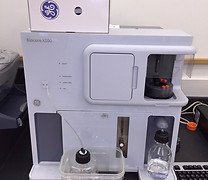
Modelling / Bioinformatics
For the Bioinformatics/Modelling, 5 newly acquired Linux Worstations (2011-2012) , a 4.5 terabyte Linux-server, a cluster of 64 cores composed of 16 Intel Core2 Quad Q6600 2.40Ghz are available. Two Metrocubo supercomputing solution MC-4tera GPU machines (DualXeon 2 Ghz, 12GB RAM, 1.5 TB disk, 4 GTX480 (1900 cores, ca. 7 Teraflops) corresponding to ca. 3800 cores for MD calculation are installed and available in the group. Several programs for solving X-ray structures such as the XDS suite and Mosfilm for processing single crystal diffraction data, the CCP4 suite, Phoenix (automated map interpretation, model building and refinement), CNS (refinement) and coot (visualization of maps and manual model building) are available on the server. Beam time at the Swiss Light Source (SLS) in Villigen is allocated regularly to the group. Furthermore, on the server a series of molecular modeling software (Sybyl package, Schrödinger package) dedicated to drug design are installed. On the server, further molecular modelling programs are available for MD simulations (NAMD, GROMACS and AMBER), for Docking studies and target-based virtual screening (GOLD, FlexX, Surflex, DOCK, Autodock), for ligand based virtual screening (ROCS software) and for predicting ADMET properties VolSurf, DEREK (Tox prediction) and Metasite (Metabolism prediction).

Schrödinger Software for Linux
Organic Synthesis
The wet-lab facilities include a fully equipped lab for performing synthesis of small molecule probes including an automated Flash chromatography system (REVELERIS® Prep Purification System, Grace) and reactors for parallel synthesis.

Synthesis laboratory

Reveleris Prep Purification System
Biochemistry
The wet-lab facilities include a protein chemistry laboratory for expression, purification as well as crystallization of proteins (fermentation facilities for bacteria and insect cells), Centrifuge (Sorvall LYNX 4000), kinetics (scintillation counter), CD, ITC, Biacore X100, qPCR (Biorad iCycler) for DSF, fluorescence spectrometer, Monolith NT.115 (nanotemper technology for thermophorisis)for binding measurement as well as a cell culture laboratory (90 sqm) for carrying out the proposed investigations (Functional biosensor assay development) up to class 2 activities (BUWAL notification) are available for use in Prof. Scapozza’s group. For the purification of proteins three Aekta purifier (room temperature and 4oC degree) are available.

Sorvall LYNX 4000

Biacore X100
Biacore X100

Bio Rad iCycler
Analytics
Analytical tools like UV/VIS spectrophotometer, two 96-well multi-plate reader of the type Synergy HT and a BMG CLARIOstar with possibility of developing Florescence polarisation based assays, HPLC and UPLC coupled with UV and diodes array, two UPLC coupled with a Xevo TQ MS and 600 MHz NMR are also available for protein stability study. An AF2000-MALS from Postnova is available for accurate analysis of protein aggregates using multiple angle light scattering technology. "FDSS µCELL" from Hamamatsu (Functional Drug Screening System (FDSS) is a kinetic plate reader with an integrated dispensing head and imaging-based detector) is available for performing HTS using the BRET-technology. Access to the in house crystallization medium throughput facility constituted by a manual 96 tips head robot for reservoir dispensing, a nanoliter robot for “on the fly” dispensing in 96 wells plates and an automatic imaging system for follow-up of the crystallization experiments (50 plates capacity) is granted. Microscopes, temperature-controlled as well as a PX scanner for directly assessing crystal quality in crystallization boxes incubators are available at the host laboratory. An X-ray data collection system consisting in a STOE X-ray Stadi Vari system mounting a GeniX Cu very high flux (Xenocs source and optics), a Stoe Stadi Vari 2-circle goniometer with fixed chi phi axis and a PILATUS 300K (Dectris) detector has been recently acquired by the host lab in collaboration with the two colleagues of Biology and is available.A cryostream 700 is incorporated into the system for cryo measurements. The system is controlled using the Stoe control and data acquisition software “X-Area”.

UPLC coupled with UV and diodes array
Bioimaging
Setup for live cell fluorescent imaging microscopy. This imaging setup shown was used for the online measurements of biochemical signaling in living cells stimulated using different approaches. It consists of a monochromator and a Spectra-X 7 channels LED light source that allows the selection of a specific wavelength and the quick shift between several wavelengths, a high sensitivity sCMOS camera, an inverted microscope with objectives equipped for high resolution fluorescence imaging, a perfusion chamber, a manifold that allows the quick and swift introduction of 8 different buffers to cells under a specific field and a data acquisition and analysis software.

Live cell fluorescent imaging microscopy
